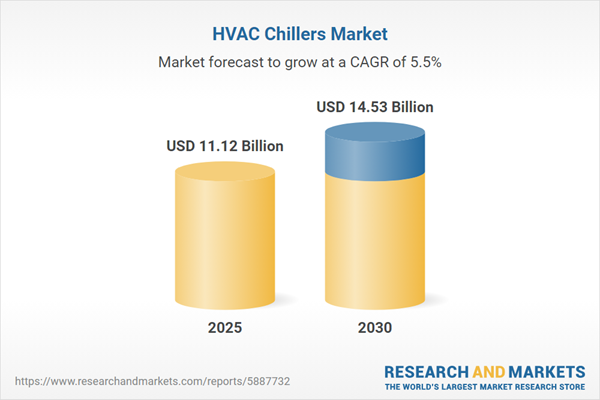Speak directly to the analyst to clarify any post sales queries you may have.
The HVAC Chillers Market is evolving rapidly, driven by sustainability demands, advances in digital controls, and shifting regulatory frameworks. Senior decision-makers seeking future-ready climate control solutions must assess the sector's shifting landscape and strategic opportunities.
Market Snapshot: Insights into the HVAC Chillers Market
The HVAC Chillers Market grew from USD 10.55 billion in 2024 to USD 11.12 billion in 2025. The market is projected to expand at a CAGR of 5.47%, reaching USD 14.53 billion by 2030. Growth is supported by rising energy efficiency standards, increased investments in infrastructure, and the global transition toward low-global-warming-potential refrigerants. Market participants are navigating a period of transformation, emphasizing technology integration and sustainability alignment to maintain competitiveness.
Scope & Segmentation: Extensive Market Coverage and Dynamic Segments
This report provides comprehensive coverage of the HVAC Chillers Market, dissecting trends across pivotal segments and regions:
- Chiller Types: Absorption (Direct-Fired, Double-Effect, Single-Effect) and Vapor Compression (Centrifugal, Reciprocating, Screw, Scroll) options cater to diverse cooling requirements.
- Capacity Ranges: Solutions from below 200 kW to above 500 kW support projects of varying scale and application complexity.
- Heat Rejection Methods: Offerings include Air-Cooled (Fin-And-Tube Coil, Microchannel Coil), Water-Cooled (Adiabatic/Hybrid, Cooling Tower), Evaporative Condensed, and Hybrid/Free-Cooling Integrated chillers.
- Energy Sources: Direct-Fired Gas, Electric-Driven, Hot Water-Driven, Steam-Driven models allow for flexibility in operational strategies and cost management.
- Configuration: Modular (Parallel Piped Plant, Stackable Modules), Packaged (Monobloc), and Split System platforms for optimized system layouts and installation versatility.
- End-Use Segment: Target sectors span Commercial (Data Centers, Education, Healthcare, Hospitality, Office Buildings, Retail & Malls), Industrial (Automotive, Chemicals & Petrochemicals, Food & Beverage, Pharmaceuticals, Plastics & Rubber, Semiconductor & Electronics), Institutional & Public (Government & Civic, Military & Defense, Utilities).
- Distribution Channels: Product reach is optimized via Direct Sales, Distributors/Dealers, and Online Channels.
- Regional Coverage: Markets are analyzed across Americas (North and Latin America), Europe, Middle East & Africa (with distinct focus on leading European economies and growing Middle Eastern and African markets), and Asia-Pacific (including China, India, and Southeast Asian countries).
- Company Developments: Detailed insights on strategies and innovations from industry leaders such as Daikin Industries, Trane Technologies, Johnson Controls International, Carrier Global Corporation, and others.
Key Takeaways for Decision-Makers
- Rising reliance on low-GWP refrigerants and high-efficiency compressors reflects industry-wide commitment to sustainability initiatives and compliance with global standards.
- Integration of IoT sensors and advanced analytics is transforming HVAC chillers into intelligent assets, enabling proactive maintenance and reducing operational risks.
- End users across data centers, healthcare, and manufacturing increasingly demand chillers that interface seamlessly with building management systems to ensure efficiency and cost control.
- Regional variations, such as preference for air-cooled solutions in water-scarce Asia-Pacific markets or retrofitting activity in the Americas, require localized go-to-market strategies.
- Market leaders are advancing through R&D investments, strategic partnerships, and expanding service portfolios to deliver customized and reliable cooling solutions.
Tariff Impact: Navigating Supply Chain and Competitive Pressures
The introduction of new tariffs in the United States for 2025 is set to alter supply chain economics in the HVAC chillers market. Senior leaders must consider how increased component costs may influence sourcing decisions. Near-shoring and domestic assembly are gaining traction as ways to mitigate volatility. Additionally, some organizations are accelerating procurement or adopting hybrid refurbishment strategies to manage cost uncertainty and sustain long-term service continuity.
Research Methodology & Data Sources
Our findings are supported by in-depth primary research, including executive and technical interviews, as well as targeted user surveys. Secondary research draws from industry publications, regulatory records, and technical white papers. Advanced data triangulation and peer reviews by industry experts ensure credible and actionable insights.
Why This Report Matters
- Enables senior stakeholders to benchmark potential investments across multiple chiller technologies and configurations.
- Informs procurement strategies with up-to-date regional and regulatory intelligence, supporting resilient supply chain decisions amid ongoing tariff adjustments.
- Helps identify partnership and portfolio expansion opportunities based on nuanced analysis of end-use demand and competitive innovation.
Conclusion: Strategic Outlook for HVAC Chillers
The HVAC Chillers Market is set for ongoing transformation through innovation, supply chain adaptation, and sustainability leadership. Stakeholders equipped with comprehensive market intelligence will be well-positioned to make informed, future-focused decisions in a complex landscape.
Additional Product Information:
- Purchase of this report includes 1 year online access with quarterly updates.
- This report can be updated on request. Please contact our Customer Experience team using the Ask a Question widget on our website.
Table of Contents
3. Executive Summary
4. Market Overview
7. Cumulative Impact of Artificial Intelligence 2025
Companies Mentioned
The companies profiled in this HVAC Chillers market report include:- Aermec S.p.A.
- Airedale International Air Conditioning Ltd. by Modine
- Blue Star Limited
- Carrier Global Corporation
- Daikin Industries, Ltd.
- Danfoss A/S
- Emerson Electric Co.
- Fujitsu Limited
- GESON REFRIGERATION EQUIPMENT CO., LTD.
- Glen Dimplex Deutschland GmbH
- inTEST Thermal Solutions
- Johnson Controls International PLC
- Kaltra GmbH
- Kirloskar Chillers Pvt Ltd
- LG Electronics Inc.
- Mitsubishi Heavy Industries, Ltd.
- Panasonic Holdings Corporation
- S.K.M Air Conditioning LLC
- Samsung Electronics Co., Ltd.
- ShenChuangYi (SCY) Refrigeration Equipment Co., Ltd
- Shuangliang Eco-Energy Systems Co.,Ltd.
- Siemens AG
- Smardt Chiller Group, Inc.
- STULZ GMBH
- Swegon Operations s.r.l.
- Thermal Care, Inc.
- Trane Technologies Company, LLC
Table Information
| Report Attribute | Details |
|---|---|
| No. of Pages | 194 |
| Published | November 2025 |
| Forecast Period | 2025 - 2030 |
| Estimated Market Value ( USD | $ 11.12 Billion |
| Forecasted Market Value ( USD | $ 14.53 Billion |
| Compound Annual Growth Rate | 5.4% |
| Regions Covered | Global |
| No. of Companies Mentioned | 28 |









